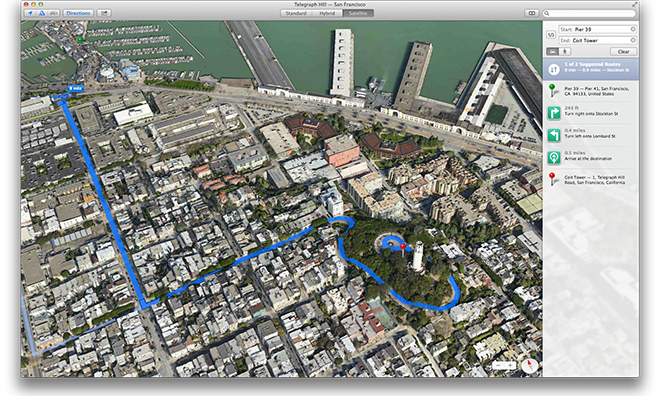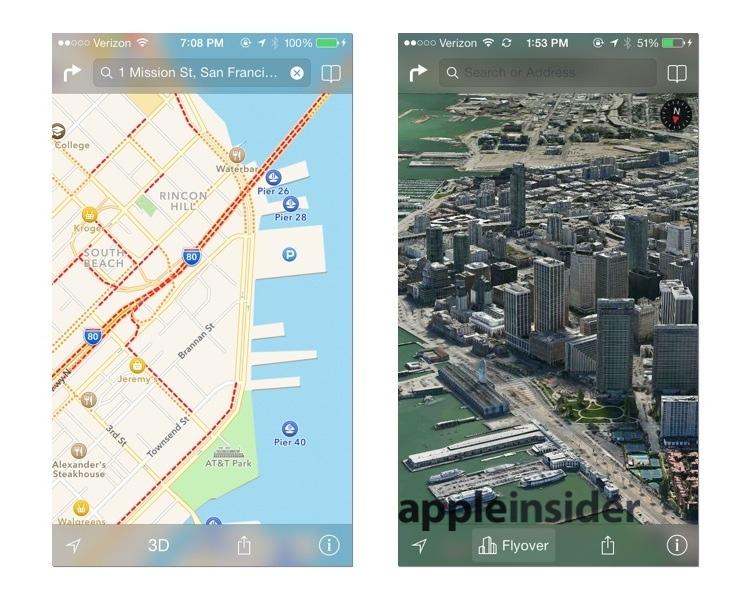Apple's recent mapping-related acquisition spree is expected to bear fruit in the next generation of iOS as the company's mapping team is said to be preparing a new transit direction feature and significant improvements to the maps' underlying data.
Lack of built-in transit support is perhaps one of the most oft-cited failures of Apple's mapping efforts. Currently, in iOS 7, Apple's Maps application will recommend and link to third-party software, including competitors like Google Maps, when users seek public transportation data.
The company has made a number of moves toward filling that gap — notably acquiring transit apps HopStop and Embark last year, signaling that the company plans to add its own built-in transit support in the future. But since the launch of Apple Maps in iOS 6 in 2012, transit data has continued to be a glaring omission.
However, it's now expected that data from Apple acquisitions Embark and HopStop will be combined in a newly revamped version of Maps for iOS 8, according to a new report on Tuesday from 9to5Mac. Apple's transit directions system will reportedly support train, bus, and subway data in major North American cities at launch.
It's claimed that users will be able to get transit directions through Maps immediately, or use the system to plan travel at a later time, such as determining the fastest route to a meeting during rush hour.
Aside from its outside mapping purchases, which also include GIS firm BroadMap, Apple has been seen hiring internally for the new transit features. Job listings for a "Maps Public Transit Engineering Manager" and a "Maps C++ Software Engineer - Public Transit" appeared on the company's career portal last fall.
Supporting the new transit functionality will be a beefed-up data backend that will also serve to make manual way-finding and point-of-interest information more reliable based on new partnerships and data brought in-house as part of its other acquisitions. Apple will also introduce an updated labeling system and tweaked "cartography design" to make maps more readable.
Apple's mapping system launched to much fanfare but was widely panned by users as being less reliable than Google's offering, leading Apple CEO Tim Cook to issue a public apology. The botched rollout cost former iOS chief Scott Forstall his job and responsibility for the system's improvement was given to Apple's internal "fixer," software and services boss Eddy Cue, under whose direction the service has made significant strides.
 Shane Cole
Shane Cole








-m.jpg)






 Thomas Sibilly
Thomas Sibilly
 Wesley Hilliard
Wesley Hilliard
 Marko Zivkovic
Marko Zivkovic

 Malcolm Owen
Malcolm Owen

 Amber Neely
Amber Neely

-xl-m.jpg)








48 Comments
Looks great, but...
Quote:
However, it's now expected that data from Apple acquisitions Embark and HopStop will be combined in a newly revamped version of Maps for iOS 8, according to a new report on Tuesday from 9to5Mac. Apple's transit directions system will reportedly support train, bus, and subway data in major North American cities at launch.
Only in selected NA cities? That would be pretty disappointing.
Personally, I'm finding Apple Maps more accurate than Google's maps recently (with or without bus or walking data).
Only in selected NA cities? That would be pretty disappointing.
Really? Can the company do anything to please people like you? Google Maps' transit functionality did not support EVERY city in the world and work perfectly when it initially came out. It still does not. Now that Apple may enter the transit arena people like you will throw stones just to throw stones. Look for Google Maps' transit functionality to get a major overhaul before iOS 8 is made available to developers come WWDC in June.
[quote name="leavingthebigG" url="/t/163479/apple-expected-to-leverage-hopstop-embark-acquisitions-for-transit-data-in-ios-8-maps#post_2485010"]Really? Can the company do anything to please people like you? Google Maps' transit functionality did not support EVERY city in the world and work perfectly when it initially came out. It still does not. Now that Apple may enter the transit arena people like you will throw stones just to throw stones. Look for Google Maps' transit functionality to get a major overhaul before iOS 8 is made available to developers come WWDC in June. [/quote] Google maps on the desktop has become a mystifying mess. Some previously usable features have either disappeared or the UI changes have rendered them invisible.
[quote name="SpamSandwich" url="/t/163479/apple-expected-to-leverage-hopstop-embark-acquisitions-for-transit-data-in-ios-8-maps#post_2485009"]Personally, I'm finding Apple Maps more accurate than Google's maps recently (with or without bus or walking data).[/quote] It made great strides since launch but I have to say from my experience data accuracy is not yet on par with Google Maps, especially outside of the US (not that Google Maps is perfect by any means). But it's getting there one step at a time :). I would really like to see Apple launch a mapmaker of sorts to speed up data corrections (time between report and fix is still Apple Maps Achilles' heel in my opinion). Must say I like the addition of advanced route planning, I regularly use it on Google Maps so it will be nice to have on Apple Maps as well.